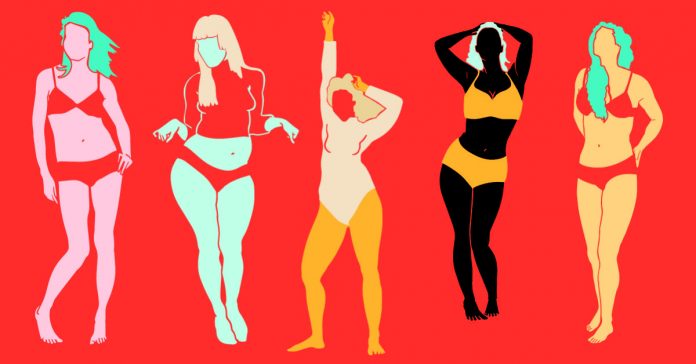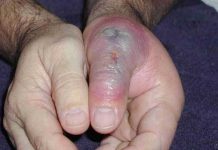Every body is beautiful
Bodies come in all different shapes and sizes. That’s part of what makes each of us unique.
It’s important to know that there isn’t an “average” or “typical” body.
Some of us are curvier, some of us have narrower hips or broader shoulders — we’re all a little bit different.
Still, most of us can categorize our shape into a few broad categories.
For example, a 2004 study reported that descriptions of female bodies have historically been described in categories based on shapes, such as triangle, rectangle, diamond, oval, and hourglass.
Some of the most common general categories include:
rectangle
triangle or “pear”
inverted triangle or “apple”
hourglass
These are just a few of the different body types that you might hear about.
So what are these different body types?
It’s important to remember that categorizing body types isn’t an exact science.
Oftentimes, there’s a lot of variation within one “type.”
You may find that your individual shape features characteristics from several of the different body types discussed below:
Rectangle, straight, or “banana”
If your waist measurements are about the same as your hip or bust, and your shoulders and hips are about the same width, you have what’s called a “banana” or rectangle body type.
Stylists will probably point you toward off-the-shoulder tops, tube dresses, and belted waists.
Triangle or “pear”
With this shape, your shoulders and bust are narrower than your hips.
You probably have slim arms and a fairly defined waist. Your waist most likely slopes out to your hips.
Stylists often recommend clothing that shows off the waistline.
Spoon
The spoon body type is pretty similar to the triangle or “pear” shape.
Your hips are larger than your bust or the rest of your body and may have a “shelf”-like appearance.
You likely have a defined waist. You may also carry some weight in your upper arms and upper thighs.
You may be told to look for dresses that have classic “baby doll” cuts or other items with an empire waist.
Hourglass
If your hips and bust are nearly equal in size and you have a well-defined waist that’s narrower than both, you have an hourglass shape.
Your legs and upper body are probably considered proportionate.
Your shoulders may be slightly rounded, and you most likely have a rounded buttocks.
Form-fitting or tailored clothing have traditionally been designed with this body type in mind.
Top hourglass
As a top hourglass, you have the general hourglass shape, but your bust measurements are slightly larger than your hips.
Boot cut or slightly flared pants probably fit you well, as do full or A-line skirts and tailored jackets.
Bottom hourglass
As a bottom hourglass, you have the general hourglass shape, but your hip measurements are slightly larger than your bust.
Stylists probably point you toward form-fitting knits and dresses.
Inverted triangle or “apple”
If your shoulders and bust are larger than your relatively narrow hips, you have what’s known as an inverted triangle or “apple” shape.
Stylists may recommend tops that have some shaping around the waist and more open necklines, or clothing that shows off your legs.
Round or oval
If your bust is larger than the rest of your body, your hips are narrow, and your midsection is fuller, you have what’s usually called a round or oval body type.
Stylists usually point people with this body type toward tops that flare at the top or that have vertical details.
Diamond
If you have broader hips than shoulders, a narrow bust, and a fuller waistline, you have what’s called a diamond body shape.
With this type, you may carry a little more weight in your upper legs. You may also have slender arms.
Flowy off-the-shoulder or boat-neck tops are usually recommended for this body type.
Athletic
If your body is muscular but isn’t particularly curvy, you might have an athletic body type.
Your shoulder and hip measurements are about the same.
Your waist is narrower than your shoulder and hips, but it isn’t overly-defined and looks more straight up and down.
Stylists often point to halter, strapless, and racerback styles.
What’s with the fruit metaphors?
Using fruit to describe body types has long been seen by some as a visual shorthand; a way to describe the shape in a less technical or scientific way.
For example, “pear shape” is a lot easier to imagine than “gynoid,” though both mean the same thing.
That said, a lot of people aren’t fans of these fruit-based metaphors.
Many feel that using these terms contributes to objectification by turning one’s body into an object for others to evaluate.
This may help perpetuate the false idea that there’s an “ideal” or “most desirable” body type.
In a study on objectification theoryTrusted Source, researchers Barbara Fredrickson and Tomi-Ann Roberts write:
“This perspective on self can lead to habitual body monitoring, which, in turn, can increase women’s opportunities for shame and anxiety, reduce opportunities for peak motivational states, and diminish awareness of internal bodily states.
Accumulations of such experiences may help account for an array of mental health risks that disproportionately affect women: unipolar depression, sexual dysfunction, and eating disorders.”
This is especially true when magazines and other mediums encourage people with certain body types to hide or “correct” their bodies instead of celebrating them for their differences.
So if you don’t like being compared to fruit, know you’re not alone.
How you describe your body is up to you and you alone. No one else can label it for you.
How to take your measurements
Maybe you immediately recognized your body type in this list of categories, maybe you didn’t.
If you want a little help, you can always take your measurements and use those figures to help guide you.
Your measurements can also be helpful for general clothes shopping, regardless of the “type” they might fall into.
Here’s how to accurately take your measurements:
Shoulders
You’re going to need some help for this one. Have a friend or someone else you trust measure across your back from the edge of one shoulder to the other.
Bust
Place one end of the tape measure on the fullest part of your bust, then wrap it around yourself. Make sure to go under your armpits and around your shoulder blades.
Waist
Circle your natural waistline — the area above your belly button but below your rib cage — with the measuring tape like it’s a belt.
If you want an easy way to make sure you’re measuring the right spot, bend slightly to the side. You’ll likely see a small crease form — that’s your natural waistline.
Hips
Hold one end of the measuring tape on the front of one of your hips, then wrap the measuring tape around yourself. Make sure you go over the largest part of your buttocks.
What factors affect your body shape?
Some elements of your body type are determined by your bone structure.
For example, some people have a curvier, rounder buttocks and curvature in their spine.
Others may have wider hips, shorter legs, or longer torsos.
How tall or short you are will also affect the overall shape of your body.
By the time you reach adulthood, your bone structure and proportions are largely established — even if your measurements change as you gain or lose weight.
Genetics also play a role. Your genes determine how your body accumulates and stores fat.
And in many cases, body fat isn’t evenly distributed.
Some may find that they typically store fat in their mid-section, while others may put weight on in their thighs, legs, or arms first.
Hormones can also affect your body shape.
For example, stress can trigger your body to release the hormone cortisol. ResearchTrusted Source suggests that stress-induced cortisol may be tied to fat buildup around your most vital organs in your mid-section.
Estrogen and progesterone, released by sexual organs, can also affect how your body stores fat. Estrogen, for example, can lead your body to store fat in your lower abdomen.
Can your shape change over time?
Aging is one of the main factors affecting your shape and size over time.
Older adults tend to have higher levels of body fat overall. Two contributing factors include a slowing metabolism and gradual loss of muscle tissue.
Aging can also affect mobility, resulting in a more sedentary lifestyle. This could lead to weight gain.
Aging can even affect your height. Many people find that they gradually become shorterTrusted Source after age 30. This can affect how your body looks overall.
According to a 2016 reviewTrusted Source, menopause may also change your body shape and fat distribution by redistributing more weight to your abdomen.
In other words, this hormonal transition may cause you to change from a “pear” to more of an “apple” shape.
Your body shape may also change if you gain or lose weight — but these changes will be slight.
That’s because the way your body stores fat and your overall bone structure will stay the same.
What if you want to change your shape?
If you want to change certain things about yourself — for you and because you want to — exercise could make a difference.
Regular exercise can help build lean muscle mass and give your body definition.
This may help you emphasize certain features or alter your overall shape.
For example, you might be able to give your arms more muscle definition with regular training.
However, it’s important to remember that a lot of what determines your shape is set in stone by your bone structure, genetics, and overall build.
Much like you can’t exercise your way into being taller, you can’t tell your body where to store fat.
Research has also found that genetic factors can affect your resting metabolic rateTrusted Source.
This may affect how quickly you lose or gain weight — even if you change how much you exercise.



























